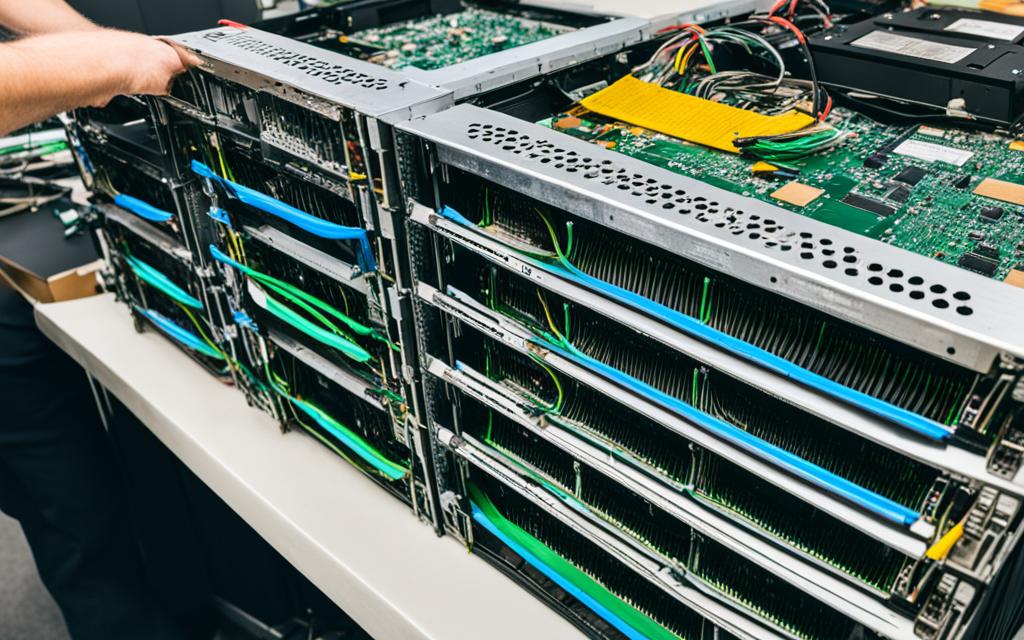Why Server Recycling is Critical for Cloud Computing Sustainability
Server recycling plays a crucial role in ensuring the sustainability of cloud computing. The shift to cloud-based services has revolutionised the way we interact with technology and offers many benefits, such as scalability, energy efficiency, and reduced environmental impact. However, the lifecycle of servers, from production to recycling, is essential for minimising waste and maximising environmental sustainability.
Proper server recycling practices, including efficient resource use and recycling, contribute to a greener future for our technology-driven world. By recycling servers, we can recover valuable materials and reduce the environmental impact of e-waste. Additionally, when servers reach the end of their lifecycle, recycling them ensures that their components are repurposed or disposed of responsibly, minimizing their contribution to landfill waste.
Server recycling also aligns with the circular economy approach, which focuses on reducing waste and optimizing resource utilization. By recycling servers, we can close the loop of resource consumption and create a more sustainable system where materials are reused rather than discarded.
Moreover, server recycling reduces the demand for new server production, which results in energy and resource savings. It allows us to extend the lifespan of existing servers and delay the need for new ones. By doing so, we can reduce the carbon footprint associated with server manufacturing, transportation, and disposal. Ultimately, server recycling is a crucial step towards achieving cloud computing sustainability.
In the following sections, we will explore the sustainable promise of the cloud, the complexity of carbon footprint in cloud computing, smart innovations in the industry, the role of regulation and customer demand, and why cloud computing is environmentally sustainable.
The Sustainable Promise of the Cloud
Cloud computing holds the promise of sustainability in the digital world. It offers scalability and elasticity, allowing for efficient resource utilization and minimizing waste. The sustainability of cloud computing heavily depends on the energy sources powering data centers. The use of renewable energy sources can significantly reduce the environmental impact. Additionally, water consumption for cooling and heat generation should be minimized through innovative cooling technology and heat reutilization. Embracing a circular economy approach, which focuses on efficient resource use and recycling practices, is crucial for minimizing waste and environmental impact. It’s important to consider the indirect impact of cloud services, as increased consumption patterns can offset the potential environmental benefits.
Cloud computing offers a sustainable solution in the digital age, but its environmental impact depends on several key factors. To ensure a sustainable cloud, the energy sources used to power data centers play a critical role. By harnessing renewable energy sources, such as solar and wind power, cloud providers can significantly reduce their carbon footprint and contribute to a greener future.
Furthermore, water consumption is a concern in data centers due to cooling requirements and heat generation. Innovative cooling technologies and heat reutilization can minimize water usage, improving the sustainability of cloud computing.
The circular economy approach is another key aspect of achieving sustainability in cloud computing. By embracing efficient resource use and recycling practices, cloud providers can minimize waste and contribute to a more sustainable future. This involves optimizing resource utilization, extending the lifespan of hardware, and implementing responsible recycling practices.
“Cloud computing represents a paradigm shift towards a more sustainable digital world. By harnessing renewable energy sources, minimizing water consumption, and embracing circular economy principles, cloud providers can significantly reduce their environmental impact.”
Additionally, it’s crucial to consider the indirect impact of cloud services. While the cloud offers scalability and efficiency, increased consumption and reliance on digital technologies can offset the potential environmental benefits. It is essential to monitor and mitigate the indirect impact of cloud services to ensure overall sustainability.
The Benefits of Renewable Energy Sources in Cloud Computing
Utilizing renewable energy sources to power data centers is a key strategy in achieving sustainability in cloud computing. With renewable energy, cloud providers can significantly reduce their carbon emissions and dependence on fossil fuels. This not only mitigates the environmental impact but also contributes to a more resilient and reliable energy infrastructure.
Innovative Cooling Technology and Heat Reutilization
Cooling data centers requires significant water consumption. By adopting innovative cooling technologies, such as air-side economization and liquid cooling, the water usage can be minimized. Furthermore, the heat generated by data centers can be repurposed for heating purposes, improving energy efficiency and reducing waste.
The Circular Economy Approach in Cloud Computing
Embracing a circular economy approach involves optimizing resource utilization, extending the lifespan of hardware, and implementing responsible recycling practices. This involves refurbishing and reusing hardware components, diverting waste from landfills, and promoting responsible e-waste recycling.
The Indirect Impact of Cloud Services
While the cloud offers many environmental benefits, it’s important to consider the indirect impact of increased consumption patterns. Cloud services enable digital transformation and the proliferation of online services, which can lead to increased energy consumption and carbon emissions in other sectors. It is crucial to develop strategies for mitigating and offsetting these indirect impacts to achieve true sustainability.
The table below showcases a comparison of energy sources and their environmental impact in cloud computing:
| Energy Source | Environmental Impact |
|---|---|
| Renewable Energy (e.g., solar, wind) | Significantly reduced carbon emissions and environmental impact |
| Fossil Fuels (e.g., coal, natural gas) | High carbon emissions and negative environmental impact |
| Nuclear Energy | Low carbon emissions but concerns about waste management and potential risks |
The Complexity of Carbon Footprint in Cloud Computing
Assessing the carbon footprint of cloud-based services is a complex endeavor. The concept of carbon neutrality, which is a global-scale aspiration, becomes challenging to translate to the individual level of a company or product. In order to make informed choices, users must seek transparent data provided by cloud providers.
However, the reporting of emissions by cloud providers still lacks completeness. One of the critical challenges lies in differentiating between location-based and market-based emissions. This distinction is important as it influences the true environmental impact of cloud computing.
“The complexity arises due to various factors, but with the right approach, we can strive for greater transparency and a deep understanding of the actual environmental impact of cloud computing.” – Jane Davies, Sustainability Expert at GreenTech Solutions
A clearer and more integrated reporting approach is needed to address these challenges. This way, we can gain a comprehensive understanding of the carbon footprint in cloud computing. Additionally, it is essential to have access to Scope 1, 2, and 3 reporting data on operations to conduct a thorough assessment of sustainability.
The Complexity of Carbon Footprint Reporting
The complexity of carbon footprint reporting in cloud computing arises from several interrelated factors:
- Lack of standardized methodologies for carbon footprint measurement and reporting.
- Differentiating between direct emissions (Scope 1) and indirect emissions (Scope 2 and 3) can be challenging.
- Measurement of emissions along the entire supply chain, including the extraction and production of raw materials.
- Incomplete reporting of emissions, especially in distinguishing between location-based emissions and market-based emissions.
Despite these challenges, there is a growing urgency to develop a more comprehensive and standardized approach to carbon footprint reporting in cloud computing. By doing so, we can foster greater transparency, provide accurate data, and facilitate informed decision-making for both businesses and consumers.
| Challenges | Solutions |
|---|---|
| Lack of standardized methodologies | Develop and adopt industry-wide standards for carbon footprint measurement and reporting. |
| Difficulty in differentiating direct and indirect emissions | Implement robust accounting methods to accurately measure and allocate emissions across scopes. |
| Measurement of emissions along the entire supply chain | Collaborate with suppliers to collect and report comprehensive data on emissions associated with the production and transportation of materials. |
| Incomplete reporting of emissions | Promote transparency and encourage cloud providers to disclose complete and accurate emissions data, including location-based and market-based emissions. |
Smart Innovations in Cloud Computing
Cloud providers are constantly pushing the boundaries of sustainability through smart innovations. These initiatives not only enhance efficiency but also contribute to a greener and more sustainable future. Let’s explore some of the remarkable projects and startups that are making a difference:
Microsoft’s Azure project, Natick
One of the standout innovations in cloud computing is Microsoft’s Azure project, Natick. This revolutionary project explores the feasibility of underwater data centers. By submerging data centers in the ocean, Microsoft aims to leverage the natural cooling properties of water to improve energy efficiency and reduce carbon emissions. This underwater approach also offers scalability and flexibility, allowing for faster deployments and easier maintenance.
Google’s Data Center Powered by Renewable Energy
Google is taking significant steps towards sustainability by investing 1 billion USD in a new data center in the UK. The facility is predominantly powered by renewable energy sources, such as solar and wind power. This commitment to clean energy not only reduces carbon emissions but also sets an example for other cloud providers to follow. By embracing renewable energy, Google is demonstrating the vital role that technology companies play in driving the transition to a low-carbon future.
Deep Green: Harnessing Heat for Energy Efficiency
Startups like Deep Green are making waves in the cloud computing industry with their innovative approach to energy efficiency. Deep Green utilizes the heat generated by onsite data centers to provide free hot water to nearby facilities. This innovative system reduces energy consumption and increases overall efficiency. By repurposing waste heat, Deep Green exemplifies how sustainability and cost-effectiveness can go hand in hand.
Greening of Streaming: Reducing the Environmental Impact
The streaming industry has seen exponential growth in recent years, leading to increased energy consumption and carbon emissions. Initiatives like Greening of Streaming are dedicated to minimizing the environmental impact of streaming services. By optimizing encoding techniques, improving data storage, and reducing network energy consumption, these initiatives are actively working towards a more sustainable future for streaming entertainment.
Humans Not Robots: AI Analytics for Sustainability
Humans Not Robots offers an AI-driven cloud analytics reporting platform designed to help businesses operate in a more sustainable and efficient manner. By leveraging advanced AI algorithms, this platform provides businesses with valuable insights into their energy consumption, resource utilization, and carbon footprint. Armed with this knowledge, companies can make data-driven decisions to minimize their environmental impact and drive sustainability goals.
These smart innovations in cloud computing exemplify the industry’s commitment to sustainability and environmental responsibility. By harnessing the power of technology, cloud providers are revolutionizing the way we use and manage data, while also reducing our impact on the planet.
Now, let’s take a closer look at the environmental benefits and overall sustainability of cloud computing in Section 6: Why Is Cloud Computing Environmentally Sustainable?
The Role of Regulation and Customer Demand
Stricter governmental regulations and increasing customer demand for sustainable practices are driving improvements in transparency and reporting within the cloud computing industry. Regulation is expected to play a significant role in ensuring the sustainability of cloud services, and customers are increasingly demanding more transparent and sustainable practices from cloud providers. This shift towards sustainability will not only aid in better decision-making for consumers but also encourage cloud providers to adopt more sustainable practices, enhancing the overall sustainability of cloud computing.
“Regulation and customer demand are driving positive change in the cloud computing industry.”
The government is recognizing the importance of sustainability and is imposing stricter regulations on the cloud computing industry. These regulations aim to minimize the environmental impact and ensure that cloud providers adhere to sustainable practices. By implementing these regulations, the government is actively taking part in fostering a greener and more sustainable digital ecosystem.
Customer demand is also playing a significant role in shaping the future of cloud computing. As individuals and businesses become more conscious of their environmental footprint, they are seeking cloud providers that prioritize transparency and sustainability. Customers want to know how their data is being stored, the energy sources used by the data centers, and the measures taken by cloud providers to reduce their environmental impact.
Transparency and Reporting
One of the key aspects of regulation and customer demand is the emphasis on transparency and reporting. Customers want to make informed decisions about the cloud services they choose, and cloud providers need to provide detailed information about their sustainability practices.
Transparency involves open communication and disclosure of information. Cloud providers are expected to be transparent about their energy sources, carbon emissions, recycling efforts, and overall environmental impact. This transparency enables customers to assess the sustainability performance of different providers and make choices that align with their values.
Reporting is another critical component of sustainability in the cloud computing industry. Cloud providers must accurately report their environmental impact through standardized metrics and guidelines. Clear and comprehensive reporting allows customers to evaluate the environmental footprint of cloud services and compare different providers based on their sustainability efforts.
The Power of Collaboration
Regulation and customer demand are not the sole responsibilities of governments and customers. It is crucial for cloud providers to actively collaborate and engage in sustainable practices. By working together, industry leaders can set benchmarks, share best practices, and drive innovation in sustainability.
Collaboration can take various forms, such as industry associations, partnerships with renewable energy providers, and knowledge sharing platforms. By joining forces, cloud providers can accelerate the adoption of sustainable practices and contribute to a more environmentally friendly cloud computing ecosystem.
The Way Forward
To meet the demands of regulation and customer expectations, cloud providers must prioritize transparency, reporting, and sustainable practices. Embracing renewable energy sources, optimizing server utilization, and implementing efficient cooling technologies are just a few ways cloud providers can lead the way towards a more sustainable future.
By addressing the role of regulation and customer demand, the cloud computing industry can continue to evolve and make significant progress in sustainability. The collaboration between governments, customers, and cloud providers is vital in shaping a greener and more sustainable digital landscape.
Why Is Cloud Computing Environmentally Sustainable?
Cloud computing offers a multitude of environmentally sustainable features and practices, making it a key driver for a greener future. Here are the reasons why cloud computing stands out in terms of sustainability:
Higher Utilization Rate
Cloud services boast a higher utilization rate compared to traditional on-premise infrastructure. This means that resources are utilized more efficiently, minimizing waste and maximizing efficiency. The higher utilization rate translates to reduced electricity needs and energy consumption, contributing to a more sustainable energy footprint.
Regular Hardware Refresh Speed
Cloud infrastructure providers adhere to a regular hardware refresh speed, ensuring that the latest energy-efficient hardware is utilized. This practice significantly reduces the environmental impact by harnessing the benefits of technological advancements in energy efficiency. By keeping up with hardware refresh cycles, cloud computing maintains high performance while minimizing energy consumption.
Reduced Climate Impact
Cloud-based data centers make significant contributions to reducing climate impact. Compared to traditional data centers, cloud infrastructures demonstrate a substantial reduction in carbon emissions, resulting in a lower carbon footprint for digital services. This reduction in climate impact brings us one step closer to achieving a sustainable future.
Powered by Renewable Energy
Cloud providers prioritize the use of renewable energy sources, such as solar and wind power, to power their data centers. By relying on clean and renewable energy, cloud computing minimizes reliance on fossil fuels and reduces carbon emissions. This shift towards renewable energy sources further enhances the sustainability of cloud-based services.
Better Infrastructure and Energy Efficiency
Cloud-based data centers are strategically located to minimize energy losses during transmission. Additionally, they are equipped with advanced infrastructure and energy-efficient technologies to optimize resource utilization and reduce energy consumption. These innovations ensure that cloud computing operates in an energy-efficient manner, further supporting sustainability goals.
With its higher utilization rate, regular hardware refresh speed, reduced climate impact, use of renewable energy, and better infrastructure, cloud computing is a prime example of environmental sustainability in the digital era. By embracing cloud-based solutions, businesses can contribute to a greener, more sustainable future.
Conclusion
In conclusion, server recycling plays a critical role in ensuring the sustainability of cloud computing. The cloud computing industry has revolutionized the way we interact with technology, offering scalability, energy efficiency, and reduced environmental impact. However, to maximize sustainability, it is important to consider the entire lifecycle of servers and embrace circular economy practices.
Stricter regulations and increasing customer demand for sustainable practices are driving improvements in transparency and reporting within the cloud computing industry. By adopting smart innovations, harnessing renewable energy sources, and optimizing resource utilization, cloud computing continues to pave the way for a greener future.
Server recycling is a crucial aspect of this sustainability journey, as it ensures that valuable resources are not wasted and helps minimize environmental impact. By prioritizing server recycling and embracing sustainable practices, we can collectively shape a more sustainable and efficient digital world.
FAQ
Why is server recycling critical for cloud computing sustainability?
Server recycling is critical for cloud computing sustainability because it minimizes waste and maximizes environmental sustainability. Proper server recycling practices contribute to a greener future for our technology-driven world.
What is the sustainable promise of the cloud?
The cloud offers scalability, energy efficiency, and reduced environmental impact, making it a promising solution for sustainability in the digital world. It relies on renewable energy sources, minimizes water consumption, and embraces a circular economy approach to minimize waste and environmental impact.
How complex is the carbon footprint in cloud computing?
Assessing the carbon footprint of cloud-based services is complex due to various factors. Complete and transparent emissions reporting from cloud providers is needed to understand the actual environmental impact. Currently, reporting lacks completeness, especially in differentiating between location-based and market-based emissions.
What smart innovations are being implemented in cloud computing?
Cloud providers are implementing smart innovations to enhance sustainability. Microsoft’s Azure project, Natick, explores the feasibility of underwater data centers for improved cooling and efficiency. Google has announced a 1 billion USD investment in a new UK data center predominantly powered by renewable energy. Other startups, like Deep Green, use heat generated by onsite data centers to provide free hot water, reducing energy usage. Initiatives such as Greening of Streaming and Humans Not Robots also contribute to reducing the environmental impact of the industry.
How are regulation and customer demand driving sustainability in cloud computing?
Stricter governmental regulations and increasing customer demand are driving improvements in transparency and reporting within the cloud computing industry. Regulation is expected to play a significant role in ensuring the sustainability of cloud services, and customers are increasingly demanding more transparent and sustainable practices from cloud providers.
Why is cloud computing environmentally sustainable?
Cloud computing is environmentally sustainable due to several factors. It offers a higher utilization rate compared to traditional infrastructure, reducing electricity needs and energy consumption. Regular hardware refreshes ensure the use of energy-efficient hardware, further reducing the environmental impact. Cloud-based data centers also contribute to reduced climate impact, with significant reductions in carbon emissions. Cloud providers prioritize the use of renewable energy sources to power their data centers and strategically locate them to minimize energy losses during transmission.















